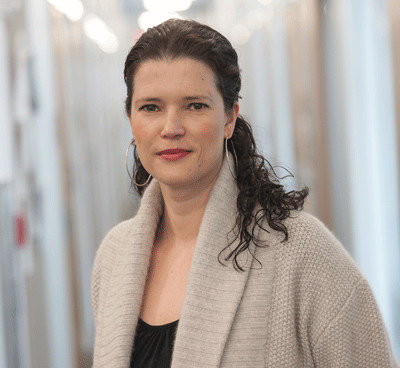 |
|
| Marian Walhout, PhD, professor of molecular medicine and co-director of the Program in Systems Biology |
Scientists at UMass Medical School have applied a powerful tool in a new way to characterize genetic variants associated with human disease. The work, published April 23 in Cell, will allow scientists to more easily and efficiently describe genomic variations underlying complex, multi-gene diseases.
“Up to this point, we’ve only been able to investigate one disease-causing mutation at a time,” said principal investigator Marian Walhout, PhD, professor of molecular medicine and co-director of the Program in Systems Biology. “We now have a robust platform that allows us to interrogate hundreds of mutations in a single experiment. This will help us develop a map of the interactions that make up the networks that control gene expression and determine how mutations in the genome give rise to a variety of human diseases.”
An explosion in whole genome studies, often called genome-wide association studies or GWAS, was brought about by vast improvements in gene sequencing technology that has helped scientists locate thousands of genetic variations associated with hundreds of different diseases. Yet, as many as 90 percent of these mutations are found in areas of the genome that don’t code for proteins, according to Dr. Walhout.
Mutations in transcription factors or their DNA binding sites can contribute to disease by disrupting gene regulation. This leads to too much, or not enough, of a target protein. A wide variety of diseases including cancer, neurological disorders, blood disorders and metabolic diseases have been linked to aberrant gene regulation.
“Most of the disease-associated mutations these GWAS have identified don’t actually change the protein itself, but are located in regulatory regions and could, therefore, change the levels of the protein,” said Juan Fuxman Bass, PhD, post-doctoral fellow and lead author of the Cell study. “The challenge for us has always been to identify how and why these mutations give rise to disease.”
Using the enhanced, gene-centered yeast one-hybrid (eY1H) assays developed in 2011 by the Walhout group, the researchers were able to perform thousands of experiments involving 1,000 transcription factors and more than 100 genetic variants. As a result, they were able to detect both loss and gain of interactions between DNA sites and transcription factors that were consistent with changes in gene expression that were found in the associated diseases.
“This system provides a tool for the in-depth interrogation of the role that genetic variation and differences in transcription factor interactions play in disrupting the gene regulatory network,” Walhout concluded. “It’s a blueprint for understanding these networks and how this connectivity is affected in disease.”
Related links on UMassMedNow:
UMMS researchers develop model for isolating effects of nutrients on gene expression
You are what you eat—even the littlest bites: New UMMS research ties dietary influences to changes in gene expression
Newsmaker: Precise makeup of diet affects health in powerful ways, UMass worm research suggests